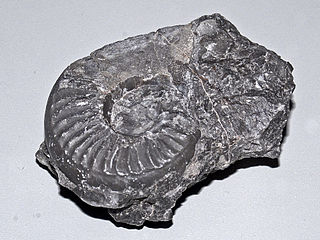
The Nautilida constitute a large and diverse order of generally coiled nautiloid cephalopods that began in the mid Paleozoic and continues to the present with a single family, the Nautilidae which includes two genera, Nautilus and Allonautilus, with six species. All told, between 22 and 34 families and 165 to 184 genera have been recognised, making this the largest order of the subclass Nautiloidea.
The Rutocertina is one of only three suborders in Shimankiy's (1957) classification of the Nautilida, the other two being the Lirocerina and Nautilina. Genera in the Rutocerina are redistributed in the Rutoceratina, Tainoceratina, and Centroceratina. The Lirocerina is redefined as the Liroceratina, and Nautilina.remains as is. In general terms these are similar to the simpler classification proposed by Kümmel 1964, wherein the Nautilida is divided into five superfamilies, the Tainocerataceae, Trigonocerataceae, Clydonautilacea, Aipocerataceae, and Nautilaceae. Shimanskiy's classification involves 34 families, Kümmel's only twenty-seven.
The Tarphycerida were the first of the coiled cephalopods, found in marine sediments from the Lower Ordovician to the Middle Devonian. Some, such as Aphetoceras and Estonioceras, are loosely coiled and gyroconic; others, such as Campbelloceras, Tarphyceras, and Trocholites, are tightly coiled, but evolute with all whorls showing. The body chamber of tarphycerids is typically long and tubular, as much as half the length of the containing whorl in most, greater than in the Silurian Ophidioceratidae. The Tarphycerida evolved from the elongated, compressed, exogastric Bassleroceratidae, probably Bassleroceras, around the end of the Gasconadian through forms like Aphetoceras. Close coiling developed rather quickly, and both gyroconic and evolute forms are found in the early middle Canadian.
The Actinocerida are an order of generally straight, medium to large cephalopods that lived during the early and middle Paleozoic, distinguished by a siphuncle composed of expanded segments that extend into the adjacent chambers, in which deposits formed within contain a system of radial canals and a narrow space along the inner side of the connecting ring known as a paraspatium. Septal necks are generally short and cyrtochoanitic, some being recumbent, some hook shaped. Most grew to lengths of about 60 to 90 cm but some, like the Huroniidae of the Silurian grew significantly larger.
The Acleistoceratidae is a family of oncocerids that contains genera characterized by depressed exogastric brevicones and cyrtocones that range from the Middle Silurian to the Middle Devonian. The siphuncle is broadly expanded, and in some actinosiphonate.
The Brevicoceratidae is a family of oncocerids that contains genera characterized by exogastric gyrocones, brevicones, and torticones. that tend to develop vestigial actinosiphonate deposits and subtriangular transverse sections. The Brevicoceratidae are derived from Oonoceras (Oncoceratidae) and range from the mid-Silurian to the Upper Devonian.
Homaloceras is an extinct nautiloid cephalopod from the Middle Devonian with a strongly curved shell, included in the nautilid family Centroceratidae.
Brevicoceras is an extinct nautiloid genus from the order Oncocerida with wide distribution in the Middle Devonian in Eastern North America, Russia and Morocco. Nautiloids form a broad group of shelled cephalopods that were once diverse and numerous but are now represented by only a handful of species in two genera.
Shuranoceras is a genus in the extinct oncocerid family Karoceratidae that plied the shallow sea floor from the Early Silurian to the Early Devonian. Shuranoceras is characterized by a smooth, compressed, slowly enlarging orthoconic shellwith a ventral submarginal siphuncle composed of complex segments. Shuranoceras was found in middle Silurian strata in Ferghana, central Asia.
The Tainoceratoidea are a superfamily in the cephalopod order Nautilida characterized by straight to loosely coiled shells, generally to a degree such that the width is greater than the height, to quadrate whorl section. Many bore spines, ribs, frills, wings, or nodes. In early forms, the siphuncle is generally near ventral, but more variable in advanced forms.
Acleistoceras is a genus of the oncocerid, nautiloid family Acleistoceratidae that lived in the shallow seas that covered much of North America during the Devonian; living from 409—383.7 mya, existing for approximately 25.3 million years.
Basslerocerida is an order of nautiloid cephalopods from the Ordovician comprising exogastric longiconic cyrtocones, that is no longer in common use.
The Graciloceratidae is a family of nautiloid cephalopods from the Middle and Upper Ordovician belonging to the Oncocerida, characterized by exogastric cyrtocones that expand slightly or moderately and have thin walled, orthochoanitic marginal or subventral, tubular siphuncles.

Oncoceratidae is a family of nauatiloid cephalopods in the order Oncocerida established by Hyatt, 1884, that range from the Middle Ordovician to the Upper Silurian.

Rutoceratidae is a family of prototypical nautilids, derived probably from either Brevicoceratidae or Acleistoceratidae of the order Oncocerida early in the Devonian. Rutoceratidae comprise a family within the oncocerid superfamily Tainocerataceae They are generally characterized by cyrtoconic and gyroconic shells, commonly with spines, nodes, or frills, although some included genera are almost orthoconic, and a commonly empty, tubular ventral siphuncle.
Hemiphragmoceratidae is a family of endogastrically brevconic oncocerids characterized by elaborately visored apertures in which the hyponomic sinus in mature specimens is on a spout-like process and there may be lateral and dorsal salients.. Shells are compressed with the apical portion curved and the anterior straight. Siphucles are nummuloideal with expanded spheroidal segments and continuously actinosiphonate interiors.

The Phragmoceratidae is a family of extinct nautiloid cephalopods from the Order Discosorida that lived during the latter part of the Silurian.
Oxygonioceras is a genus in the Oncocerid family, Brevicoceratidae, from the Middle Silurian of North America and Europe.

Tainoceratidae is a family of late Paleozoic and Triassic nautiloids that are a part of the order Nautilida, characterized by large, generally evolute shells with quadrate to rectangular whorl sections. Shells may bear ribs or nodes, or both.
The Nephriticeratidae is a family of early Paleozoic nautilod cephalopods included in the Barrandeocerina, distinguished by mostly cyrtoconic as well as gyroconic, sepenticontic, and sinstrally torticonic shells with large, typically straight necked (orthchoanitic) siphuncles. As for the suborder, connecting rings are thin.






